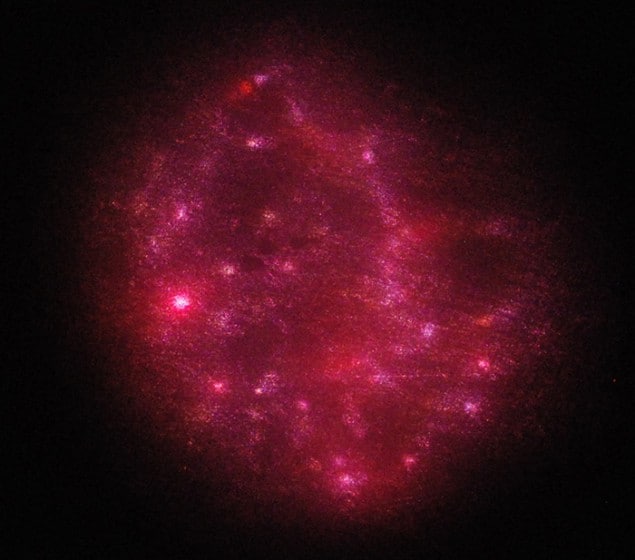
Filaments of plasma created by a high-powered laser beam undergo a similar type of phase transition as liquid percolating through a porous material. That is the conclusion of physicists in Switzerland who have studied filament patterns in the lab and say that their findings could improve our understanding of phase transitions in general. The research could also lead to plasma filaments being used for the diversion of lightning strikes and for cloud seeding.
Filaments are bright streaks of light a few microns wide and up to several metres long that are created when a laser beam ionizes the air it travels through. This occurs at laser powers above a certain threshold when the beam “self-focuses” and so increases its intensity to the point where ionization occurs.
Variations and fluctuations
If the beam measures just a few millimetres across, then all of its power will be self-focused into one narrow beam and it will produce just a single filament. However, small variations in transverse intensity as well as fluctuations in atmospheric refractive index will cause beams with diameters of a few centimetres to self-focus at multiple narrow beams across its width. This results in large numbers of filaments – up to 1000 – more or less randomly distributed across the beam’s cross section.
In 2010 Jérôme Kasparian and Jean-Pierre Wolf of the University of Geneva, working with several groups of physicists from Germany, reported observing multiple filaments in 100 TW(1014 W) laser pulses with diameters of 9 cm. Recording the beam’s intensity using photographic paper positioned at various distances up to 15 m from the light source, the researchers saw that the filaments initially joined together to form a single cluster but then broke up into several clusters as the beam propagated forward – the result, they say, of each filament progressively draining the light from around itself.
However, Kasparian’s Geneva-based colleague Wahb Ettoumi, who is a statistical physicist, noticed something else. Looking more closely at the beam’s changing cross-sectional structure, Ettoumi observed a single cluster stretched across the width of the beam at distances of up to about 5 m. But he noticed that, within the space of a few tens of centimetres, the single cluster is replaced by many small, disconnected clusters centred on individual plasma filaments. Furthermore, the precise distance at which this occurred depended on the parameters of the beam. The sudden switch, he thought, resembled a phase change in models that describe percolation.
Coffee connections
Such models describe how individual pores within a solid material, be it a permeable rock or ground coffee beans, for example, suddenly connect up to allow a liquid to pass from one side of the material to the other as that material’s porosity is gradually increased. In the case of laser filaments, however, the connectivity instead drops suddenly as beam displacement increases. “I asked myself whether this was just an accidental resemblance,” Ettoumi says, “but then when we started studying these patterns we slowly realized there was something deeper going on.”
To check that his hunch was correct, Ettoumi, Kasparian and Wolf made a careful study of the filament patterns. They also carried out computer simulations of the beam in order to visualize the beam’s profile at a greater range of propagation distances. Doing so, they confirmed that the beam does indeed undergo a phase transition. However, they found that the transition differed slightly from the one that governs percolation. In particular there exists a minimum size of filament cluster – due to the robustness of single filaments – that does not occur under standard percolation.
The researchers say the results show laser filamentation to be a “very promising” system for investigating phase transitions, given that the transition can be directly observed and the relevant parameter – propagation distance – changes continuously. But they also believe that the work could find applications outside the lab. In principle, filaments produced by a powerful laser beam pointed at a cumulonimbus cloud could be used as conducting channels to guide lightning safely to ground. However, the limited length of individual filaments means that electrons would have to “hop” from one filament to another. Optimizing this hopping, says Ettoumi, would depend on knowing the intensity distribution across the beam.
Rainmaking filaments
According to Ettoumi, laser filaments might also be applied to rainmaking. They could, he explains, be used to break apart molecules in the atmosphere in order that the resulting fragments serve as nuclei around which water vapour condenses and forms droplets. “This could be used to trigger rain,” he says. “To date it has been shown to work in a cloud chamber, but not over longer distances.”
Daniele Faccio of Heriot Watt University in the UK believes the latest work could prove useful both scientifically and practically. He says that seeing a new kind of phase transition in an optical system, as opposed to a more conventional atomic system, “stimulates new ways of thinking”. But he cautions that any new insights will need to account for the observed phase transition’s departure from standard percolation theory.
The work is described in Physical Review Letters.


